coal
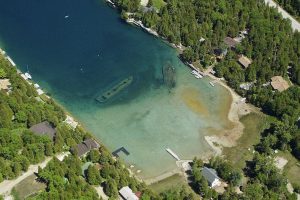 On August 23, 1885, the schooner, Sweepstakes hit a rock near Cove Island on the Canadian side of Lake Huron, and sank in shallow water close to the light station. There she remained until transport could be arranged. Sweepstakes was built in Burlington, Ontario in 1867, by Melancthon Simpson. The wooden schooner’s had two masts, and sported a length 119 feet. The hull’s maximum depth was 20 feet. The schooner weighed approximately 218 tons. Sweepstakes was last owned by George Stewart, who lived in Mooretown, Ontario. Because she ran aground on a rock, her crew were able to escape, so her sinking took with it only one casualty…Sweepstakes, herself. She rests in the Fathom Five National Marine Park.
On August 23, 1885, the schooner, Sweepstakes hit a rock near Cove Island on the Canadian side of Lake Huron, and sank in shallow water close to the light station. There she remained until transport could be arranged. Sweepstakes was built in Burlington, Ontario in 1867, by Melancthon Simpson. The wooden schooner’s had two masts, and sported a length 119 feet. The hull’s maximum depth was 20 feet. The schooner weighed approximately 218 tons. Sweepstakes was last owned by George Stewart, who lived in Mooretown, Ontario. Because she ran aground on a rock, her crew were able to escape, so her sinking took with it only one casualty…Sweepstakes, herself. She rests in the Fathom Five National Marine Park.
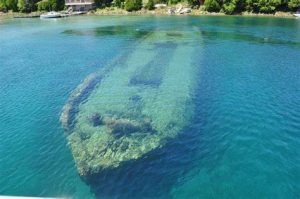
On September 3rd the tug Jessie towed Sweepstakes into Big Tub Harbor so she could be repaired, but it was found that the Sweepstakes was beyond repair. So, the repair soon became a salvage of sorts. She was stripped of all useful rigging and equipment. The she sank in her present location in Tub Harbor, at Tobermory, Ontario, Canada. At the time of her sinking, Sweepstakes was still fully loaded with coal. Her cargo was salvaged at a later date. It seems a sad end to the little ship that was majestic in her time, but it isn’t really the end for her.
The area where Sweepstakes now lies is a fairly shallow spot, so she is visible to people on small boats passing 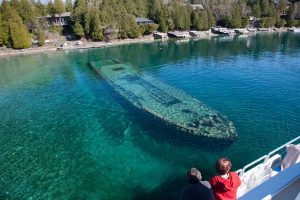 nearby. Her hull is almost completely intact, and she rests in about 20 feet of very clear water at the head of Big Tub Harbor. Two mooring buoys mark her location as a warning to unsuspecting boaters. Although deteriorating a little more each year, the Sweepstakes is one of the best preserved nineteenth-century Great Lakes schooners to be found. Nearby, the wreck of The City Of Grand Rapids rests. Both wrecks are visited frequently by glass-bottom tour boats. During the spring and fall, the site is shared by both divers and boats. Even just looking at pictures of the boats is interesting. It’s almost strange to think you can see a shipwreck from the top of the water.
nearby. Her hull is almost completely intact, and she rests in about 20 feet of very clear water at the head of Big Tub Harbor. Two mooring buoys mark her location as a warning to unsuspecting boaters. Although deteriorating a little more each year, the Sweepstakes is one of the best preserved nineteenth-century Great Lakes schooners to be found. Nearby, the wreck of The City Of Grand Rapids rests. Both wrecks are visited frequently by glass-bottom tour boats. During the spring and fall, the site is shared by both divers and boats. Even just looking at pictures of the boats is interesting. It’s almost strange to think you can see a shipwreck from the top of the water.
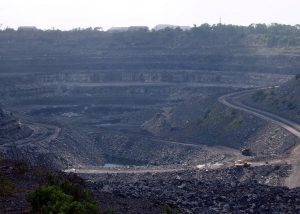
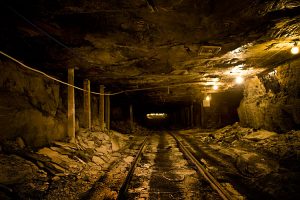 Coal mining in modern times is mostly strip mining. Scrapers systematically strip levels of earth away, and load the ore on Unit Rigs to be taken for processing. For the most part, this is a very safe way to mine coal. Mining wasn’t always that way, and in areas where underground mining is the normal mining style, accidents are bound to happen. Coal dust can be deadly. It is a fine powdered form of coal, which is created by crushing, grinding, or pulverizing the coal. Because of the brittle nature of coal, coal dust can be created during mining, transportation, or by mechanically handling coal. Grinding coal to dust before combusting it improves the speed and efficiency of burning and makes the coal easier to handle. However, coal dust is hazardous to workers if it is suspended in air outside of the controlled environment of grinding and combustion equipment. It poses the acute hazard of forming an explosive mixture in air and the chronic hazard of causing pulmonary illness in people who inhale excessive quantities of it. Coal dust in a confined space that forms an explosive mixture, can cause a mine cave in.
Coal mining in modern times is mostly strip mining. Scrapers systematically strip levels of earth away, and load the ore on Unit Rigs to be taken for processing. For the most part, this is a very safe way to mine coal. Mining wasn’t always that way, and in areas where underground mining is the normal mining style, accidents are bound to happen. Coal dust can be deadly. It is a fine powdered form of coal, which is created by crushing, grinding, or pulverizing the coal. Because of the brittle nature of coal, coal dust can be created during mining, transportation, or by mechanically handling coal. Grinding coal to dust before combusting it improves the speed and efficiency of burning and makes the coal easier to handle. However, coal dust is hazardous to workers if it is suspended in air outside of the controlled environment of grinding and combustion equipment. It poses the acute hazard of forming an explosive mixture in air and the chronic hazard of causing pulmonary illness in people who inhale excessive quantities of it. Coal dust in a confined space that forms an explosive mixture, can cause a mine cave in.
On February 27, 1943, just such a deadly combination occurred and the resulting explosion at the Montana Coal and Iron Company mine killed 74 workers. It would become the worst mining disaster in Montana’s history, and the 43rd worst in the nation. The small towns of Washoe and Bearcreek, Montana, consisted almost entirely of mine workers and their families. Most of the men worked at Smith Mine #3 for the Montana Coal and Iron Company. Saturday morning, February 27, found 77 men working in the mine. Then, at 9:30am, a huge explosion rang out. The people of Washoe and Bearcreek heard the roar and then the long, wailing siren that followed. The exact cause of the explosion is not known, though some of the company’s miners claimed methane gas had built up in some abandoned shafts and was ignited after a cave-in. The two towns are virtually ghost towns now, with Bearcreek being the only one with people living there…a total of 79 to be exact.
Inside the mine, smoke was seen pouring from the entrance…the first indication of trouble. “There’s something wrong down here, I’m getting out,” the hoist operator called up. He and two nearby miners were the last men to leave the mine alive. Rescue crews came from as far away as Butte and Cascade county, and worked around the clock in six hour shifts to clear debris and search for possible survivors. There were none. The night of March 4, workers reached the first bodies. More followed until the toll mounted to 74. Some died as the result 
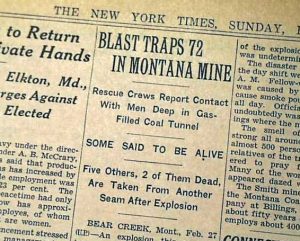 of a violent explosion in Number 3 vein, the remainder as a result of the deadly methane gasses released by the blast. Virtually every household in Washoe and Bearcreek was touched by this tragedy. All of the bodies were removed from the mine. There is a highway plaque near the mouth of the mine, which was never reopened, and there are memorials in the cemeteries in Bearcreek and nearby Red Lodge, the county seat for Carbon County.
of a violent explosion in Number 3 vein, the remainder as a result of the deadly methane gasses released by the blast. Virtually every household in Washoe and Bearcreek was touched by this tragedy. All of the bodies were removed from the mine. There is a highway plaque near the mouth of the mine, which was never reopened, and there are memorials in the cemeteries in Bearcreek and nearby Red Lodge, the county seat for Carbon County.
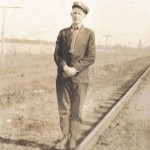 With the advent of the railroad in America back in the early 1820’s, came the fascination with trains and the railroad in general. It is a fascination that has never really ended. Even though some of our railroad tracks are now being dismantled, I don’t believe that the railroad will ever really go away. So many things are transported by rail, many of which could not feasibly be transported any other way…coal being one of the biggest industries to which the railroad is vital. My family worked in the lumber industry back in the early 1900’s, and at that time lumber and lumber products were transported by rail. There were no semi-trucks to transport things, so most things were transported to other areas of the country by rail.
With the advent of the railroad in America back in the early 1820’s, came the fascination with trains and the railroad in general. It is a fascination that has never really ended. Even though some of our railroad tracks are now being dismantled, I don’t believe that the railroad will ever really go away. So many things are transported by rail, many of which could not feasibly be transported any other way…coal being one of the biggest industries to which the railroad is vital. My family worked in the lumber industry back in the early 1900’s, and at that time lumber and lumber products were transported by rail. There were no semi-trucks to transport things, so most things were transported to other areas of the country by rail.
Early on there were huge ceremonies to celebrate the railroads entrance into a new town. 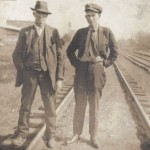 People just understood how important the railroad was to their way of life. Travel became easier, supplies and mail reached people faster, and the standard of living in the West vastly improved. It was a win win situation for everyone concerned
People just understood how important the railroad was to their way of life. Travel became easier, supplies and mail reached people faster, and the standard of living in the West vastly improved. It was a win win situation for everyone concerned
With all those changes, also came the advent of the railroad photo op. Everyone wanted their picture taken by the tracks, it seems. I have come across several pictures where the railroad tracks are the main focus of the shot. I can understand the fascination, but I was surprised by the number of people who felt the same way I did about them. Pictures weren’t as common back in the early 1900’s, although they were apparently more common than I would have thought. Still, no matter the cost, no matter how frivolous, people wanted pictures with the railroad in them. It was such a novelty, and it was a piece of history. It was their chance to prove that they were there.

Apparently, not much has changed over the decades or even the last century, because it seems to be the latest thing again, to have your picture taken on or beside the railroad tracks. Senior pictures and even family pictures are being taken there by lots of photographers, like my friend, Tammie Williamson of Williamson Creations Photography. Tammie displays railroad photographs on her photography site quite a bit. Like so many other people throughout history, she and many other people today still like the tracks for photographs. It’s just part of our fascination with the railroad, the trains, and the tracks that move them along.

